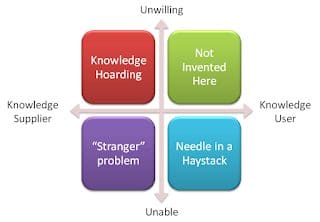How to break the 4 generic barriers to Knowledge Management.
There are only four generic barriers to KM. These are they, and all can be addressed.
The Boston Square shown here maps the unwillingness and the inability that can affect the knowledge supplier, and the knowledge user. Any combination of these is a block to the transfer of knowledge from one to the other.
The Supplier is unwilling to share.
The unwilling supplier is afflicted by Knowledge Hoarding. He or she feels they will lose something (power, job security, reputation) if they give their knowledge away. Luckily we can demonstrate that this is not true, and managers can ease the shift from hoarding to sharing by careful use of incentives, eventually outlawing hoarding entirely.
The User is Unwilling to learn.
The unwilling user is afflicted by Not Invented Here (NIH). He or she feels more secure in their own (“invented here”) knowledge than in scary knowledge from somewhere else. This barrier can be addressed by redefining “here”, so that “invented in my community” equates to “invented here“, by using performance metrics to shock people out of complacency, and eventually by outlawing NIH completely.
The Supplier is Unable to share
The unable supplier suffers from the Stranger problem – “I don’t know who to share this with”. This can be tackled through developing a Pull-based approach, so that they share by answering the questions of an individual or team (through community forums, or peer assist), or by using the concept of the “Unknown User” – the psychological construct that we can bring into retrospects and after action reviews.
The User is Unable to find knowledge
The unable user suffers from “needle in a haystack” – they don’t know where to look. Here we need the knowledge assets, that synthesised knowledge that creates the faucet rather than the firehose. We need the expertise locator. We need good search, and we need the places to ask – the community forums described above.
All four of these barriers are very real. All four can be overcome. The Ability to share and learn is provided by the creation and roll-out of a Knowledge management framework, while the Willingness to share and learn is provided by culture change and communication activities, and cemented by KM governance.


Leave a Reply